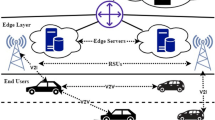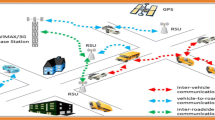Abstract
The accurate identification of malicious nodes in vehicular social networks (VSN) can ensure the secure and efficient operation of the mobile network. The roadside unit (RSU) undertakes various tasks in the internet of vehicles (IoV) and processes a large amount of data. It plays an indispensable and crucial role in the IoV. Therefore, the damage and scope of the attack on RSU are more significant. This paper proposes a trust model for detecting malicious RSUs (TMDMR) to realize the trust decision problem of the roadside unit in VSN. The trust management model is constructed by designing two main decision indicators (QoS trust and social trust) in vehicular social networks, and the algorithm is intended to complete the calculation of global trust. Finally, the global trust server implements the trust decision of RSU. The simulation results demonstrate that TMDMR is better than the comparison scheme in terms of Precision and Recall. When the malicious number of nodes is 45% during OA attack, the Precision of TMDMR is 5.3% and 26.2% higher than comparison schemes, and Recall value is also 4.7% and 30.1% higher than them, respectively. When the malicious number is 45%, TMDMR has the lowest packet dropping rate (23.8% and 44.7%) to the comparison schemes. Its end-to-end delay is 42% and 51.3% lower than other two schemes. It also has advantages in terms of response time to complete a round of detection.










Similar content being viewed by others
Data Availability
The researchers do not agree to the data sharing, so the current research data are not publicly available.
References
Kerrache, C. A., Calafate, C. T., Cano, J.-C., Lagraa, N., & Manzoni, P. (2016). Trust management for vehicular networks: An adversary-oriented overview. IEEE Access, 4, 9293–9307.
Gerla, M., Lee, E.-K., Pau, G., & Lee, U. (2014). Internet of vehicles: From intelligent grid to autonomous cars and vehicular clouds. In Internet of things (WF-IoT), 2014 IEEE world forum on (pp.241–246). IEEE.
Tonguz, O., Wisitpongphan, N., Bai, F., Mudalige, P., & Sadekar, V. (2007). Broadcasting in VANET. In Proceedings of mobile networking for vehicular environments (pp. 7–12).
Al-Shareeda, M. A., Anbar, M., Manickam, S., Khalil, A., & Hasbullah, I. H. (2021). Security and privacy schemes in vehicular ad-hoc network with identity-based cryptography approach: A survey. IEEE Access, 9, 121522–121531. https://doi.org/10.1109/ACCESS.2021.3109264
Farooq, S. M., Hussain, S. M. S., & Ustun, T. S. (2021). A survey of authentication techniques in vehicular ad-hoc networks. IEEE Intelligent Transportation Systems Magazine, 13(2), 39–52. https://doi.org/10.1109/MITS.2020.2985024
Ruohomaa, S., & Kutvonen, L. (2005). Trust management survey. Trust management (pp. 77–92). Springer.
Lu, Z., Qu, G., & Liu, Z. (2019). A survey on recent advances in vehicular network security, trust, and privacy. IEEE Transactions on Intelligent Transportation Systems, 20(2), 760–776. https://doi.org/10.1109/TITS.2018.2818888
Atzori, L., Iera, A., Morabito, G., & Nitti, M. (2012). The social internet of things (siot)–when social networks meet the internet of things: Concept, architecture and network characterization. Computer Networks, 56(16), 3594–3608.
Hussain, R., Lee, J., & Zeadally, S. (2021). Trust in VANET: A survey of current solutions and future research opportunities. IEEE Transactions on Intelligent Transportation Systems, 22(5), 2553–2571. https://doi.org/10.1109/TITS.2020.2973715
Rehman, A., Hassan, M. F., Hooi, Y. K., Qureshi, M. A., Shukla, S., Susanto, E., Rubab, S., & Abdel-Aty, A.-H. (2022). CTMF: Context-aware trust management framework for internet of vehicles. IEEE Access, 10, 73685–73701. https://doi.org/10.1109/ACCESS.2022.3189349
Zhang, C., Zhu, L., Xu, C., Sharif, K., Ding, K., Liu, X., Du, X., & Guizani, M. (2022). TPPR: A trust-based and privacy-preserving platoon recommendation scheme in VANET. IEEE Transactions on Services Computing, 15(2), 806–818. https://doi.org/10.1109/TSC.2019.2961992
Atwa, R. J., Flocchini, P., & Nayak, A. (2021). RTEAM: Risk-based trust evaluation advanced model for VANETs. IEEE Access, 9, 117772–117783. https://doi.org/10.1109/ACCESS.2021.3107467
Soleymani, S. A., Abdullah, A. H., Hassan, W. H., Anisi, M. H., Goudarzi, S., & Baee, M. A. R. (2015). Trust management in vehicular ad hoc network: A systematic review. EURASIP Journal on Wireless Communications and Networking, 1, 146.
Yao, X., Zhang, X., & Li, H. N. P. (2017). Using trust model to ensure reliable data acquisition in VANETs. Ad Hoc Networks, 5, 107–118. https://doi.org/10.1016/j.adhoc.2016.10.011
Dias, J. A. F. F., Rodrigues, J. J. P. C., Xia, F., & Mavromoustakis, C. X. (2015). A cooperative watchdog system to detect misbehavior nodes in vehicular delay-tolerant networks. IEEE Transactions on Industrial Electronics, 62(12), 7929–7937. https://doi.org/10.1109/TIE.2015.2425357
Smaldone, S., Han, L., Shankar, P., & Iftode, L. (2008). Roadspeak: Enabling voice chat on roadways using vehicular social networks. In Proceedings of the 1st workshop on social network systems (pp. 43–48).
Yang, Q., & Wang, H. (2015). Toward trustworthy vehicular social networks. IEEE Communications Magazine, 53(8), 42–47. https://doi.org/10.1109/MCOM.2015.7180506
Chen, X., & Wang, L. (2017). A trust evaluation framework using in a vehicular social environment. In 2017 IEEE conference on computer communications workshops (INFOCOM WKSHPS) (pp. 1004–1005).https://doi.org/10.1109/INFCOMW.2017.8116532
Kerrache, C. A., Lagraa, N., Hussain, R., Ahmed, S. H., Benslimane, A., Calafate, C. T., Cano, J.-C., & Vegni, A. M. (2019). TACASHI: Trust-aware communication architecture for social internet of vehicles. IEEE Internet of Things Journal, 6(4), 5870–5877. https://doi.org/10.1109/JIOT.2018.2880332
Alishev, D., Hussain, R., Nawaz, W., & Lee, J. (2017) Social-aware bootstrapping and trust establishing mechanism for vehicular social networks. In 2017 IEEE 85th vehicular technology conference (VTC Spring) (pp. 1–5). https://doi.org/10.1109/VTCSpring.2017.8108459.
Feng, X., Shi, Q., Xie, Q., & Wang, L. (2021). P2BA: A privacy-preserving protocol with batch authentication against semi-trusted RSUs in vehicular ad hoc networks. IEEE Transactions on Information Forensics and Security, 16, 3888–3899.
Baza, M., Nabil, M., Mahmoud, M. M. E. A., Bewermeier, N., Fidan, K., Alasmary, W., & Abdallah, M. (2022). Detecting sybil attacks using proofs of work and location in VANETs. IEEE Transactions on Dependable and Secure Computing, 19(1), 39–53.
Chikhaoui, O., Abassi, R., Ben Chehida Douss, A., & El Fatmi, S. G. (2019). A security mechanism against the RSU compromise attack in a ticket-based authentication scheme for VANETs. In Proceedings of the European, Mediterranean, and middle eastern conference on information systems (EMCIS) (vol. 381, pp. 403–416). Springer.
Abhishek, N. V., Aman, M. N., Lim, T. J., & Sikdar, B. (2022). DRiVe: Detecting malicious roadside units in the internet of vehicles with low latency data integrity. IEEE Internet of Things Journal, 9(5), 3270–3281. https://doi.org/10.1109/JIOT.2021.3097809
Abhishek, N. V., Lim, T. J., Sikdar, B., & Liang, B. (2019). Detecting RSU misbehavior in vehicular edge computing. In 2019 IEEE/CIC international conference on communications in China (ICCC) (pp. 42–47).https://doi.org/10.1109/ICCChina.2019.8855952
Minhas, U. F., Zhang, J., Tran, T., & Cohen, R. (2011). A multifaceted approach to modeling agent trust for effective communication in the application of mobile ad hoc vehicular networks. IEEE Transactions on Systems, Man, and Cybernetics Part C (Applications and Reviews), 41(3), 407–420. https://doi.org/10.1109/TSMCC.2010.2084571
Shabut, A. M., Dahal, K. P., Bista, S. K., & Awan, I. U. (2015). Recommendation based trust model with an effective defence scheme for MANETs. IEEE Transactions on Mobile Computing, 14(10), 2101–2115.
Qureshi, K. N., Iftikhar, A., Bhatti, S. N., Piccialli, F., Giampaolo, F., & Jeon, G. (2020). Trust management and evaluation for edge intelligence in the internet of things. Engineering Applications of Artificial Intelligence, 94, 103756.
Funding
This work was supported by the Major Science and Technology Project of Henan Province-Internal security mechanism and evaluation methods in cyberspace (No. 221100240100), National Key Research and Development Program for Young Scientists-Research and demonstration application of key technologies for endogenous security of intelligent networked vehicles (No. 2022YFB31022800), and Zhengzhou Major science and technology innovation Special Project-Research on endogenous Security Architecture of intelligent networked vehicles (No. 2021KJZX0060-3).
Author information
Authors and Affiliations
Corresponding author
Ethics declarations
Conflict of interest
The authors have no relevant conflict of interest to disclose.
Additional information
Publisher's Note
Springer Nature remains neutral with regard to jurisdictional claims in published maps and institutional affiliations.
Rights and permissions
Springer Nature or its licensor (e.g. a society or other partner) holds exclusive rights to this article under a publishing agreement with the author(s) or other rightsholder(s); author self-archiving of the accepted manuscript version of this article is solely governed by the terms of such publishing agreement and applicable law.
About this article
Cite this article
Mao, M., Yi, P., Zhang, J. et al. Detecting Malicious Roadside Units in Vehicular Social Networks for Information Service. Wireless Pers Commun 130, 2565–2588 (2023). https://doi.org/10.1007/s11277-023-10392-6
Accepted:
Published:
Issue Date:
DOI: https://doi.org/10.1007/s11277-023-10392-6




